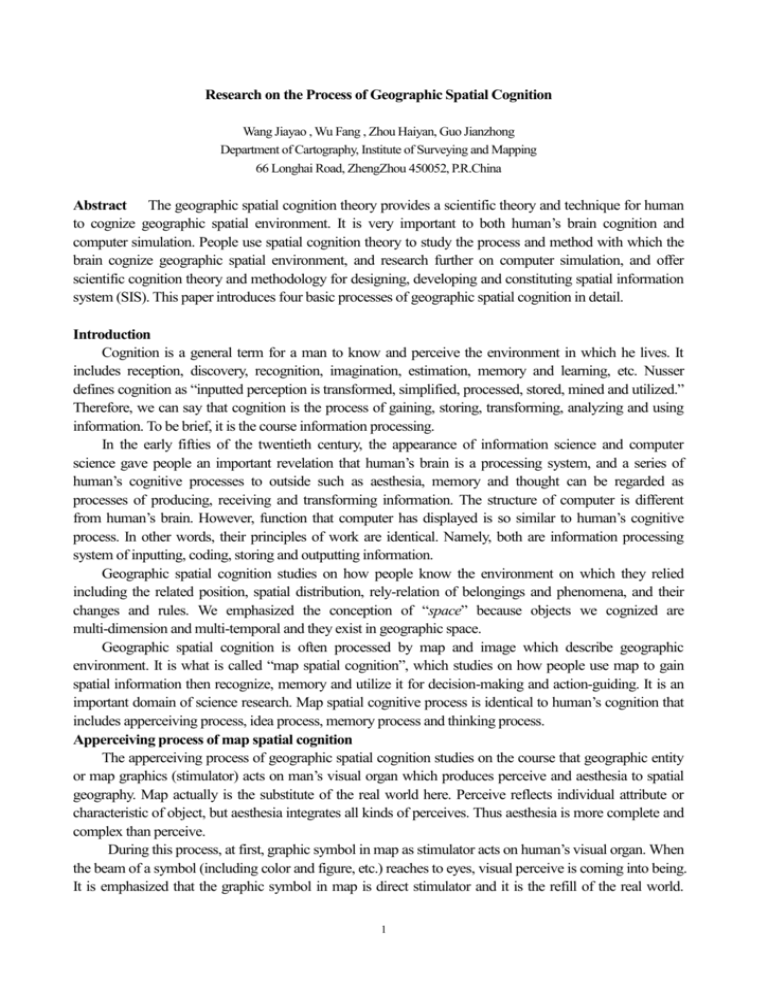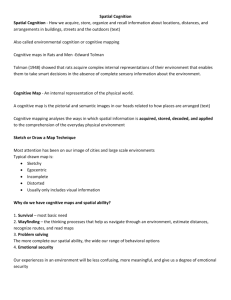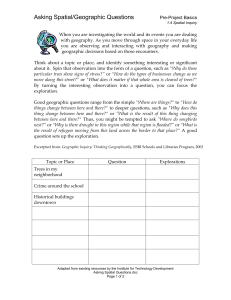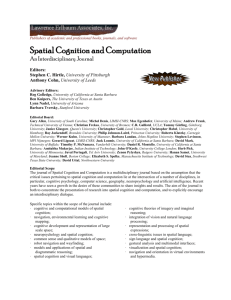Thinking process of map spatial cognition
advertisement

Research on the Process of Geographic Spatial Cognition Wang Jiayao , Wu Fang , Zhou Haiyan, Guo Jianzhong Department of Cartography, Institute of Surveying and Mapping 66 Longhai Road, ZhengZhou 450052, P.R.China Abstract The geographic spatial cognition theory provides a scientific theory and technique for human to cognize geographic spatial environment. It is very important to both human’s brain cognition and computer simulation. People use spatial cognition theory to study the process and method with which the brain cognize geographic spatial environment, and research further on computer simulation, and offer scientific cognition theory and methodology for designing, developing and constituting spatial information system (SIS). This paper introduces four basic processes of geographic spatial cognition in detail. Introduction Cognition is a general term for a man to know and perceive the environment in which he lives. It includes reception, discovery, recognition, imagination, estimation, memory and learning, etc. Nusser defines cognition as “inputted perception is transformed, simplified, processed, stored, mined and utilized.” Therefore, we can say that cognition is the process of gaining, storing, transforming, analyzing and using information. To be brief, it is the course information processing. In the early fifties of the twentieth century, the appearance of information science and computer science gave people an important revelation that human’s brain is a processing system, and a series of human’s cognitive processes to outside such as aesthesia, memory and thought can be regarded as processes of producing, receiving and transforming information. The structure of computer is different from human’s brain. However, function that computer has displayed is so similar to human’s cognitive process. In other words, their principles of work are identical. Namely, both are information processing system of inputting, coding, storing and outputting information. Geographic spatial cognition studies on how people know the environment on which they relied including the related position, spatial distribution, rely-relation of belongings and phenomena, and their changes and rules. We emphasized the conception of “space” because objects we cognized are multi-dimension and multi-temporal and they exist in geographic space. Geographic spatial cognition is often processed by map and image which describe geographic environment. It is what is called “map spatial cognition”, which studies on how people use map to gain spatial information then recognize, memory and utilize it for decision-making and action-guiding. It is an important domain of science research. Map spatial cognitive process is identical to human’s cognition that includes apperceiving process, idea process, memory process and thinking process. Apperceiving process of map spatial cognition The apperceiving process of geographic spatial cognition studies on the course that geographic entity or map graphics (stimulator) acts on man’s visual organ which produces perceive and aesthesia to spatial geography. Map actually is the substitute of the real world here. Perceive reflects individual attribute or characteristic of object, but aesthesia integrates all kinds of perceives. Thus aesthesia is more complete and complex than perceive. During this process, at first, graphic symbol in map as stimulator acts on human’s visual organ. When the beam of a symbol (including color and figure, etc.) reaches to eyes, visual perceive is coming into being. It is emphasized that the graphic symbol in map is direct stimulator and it is the refill of the real world. 1 Therefore, it needs an imagining or transforming mental process for people to obtain individual attribute or characteristic of real object. We call it “coding” in information communication. For example, when a man reads a symbol composing of three concentric circles that have different radius in a map with the scale of 1:1000000, the symbol is imaged in his retina. Then basing on map legend, he knows that it is a city with a population over 1000000. Here he really perceives a city with a population over 1000000 in real world. It is obvious that the mental process of imagining and transforming is very important. Visual perceive about map graphic symbols begins with single graphic symbol. People obtain individual property and characteristic of real object via map graphic symbol. It is the base of the aesthesia process. During aesthesia process, reflex produced in human’s brain is the reflection that integrate all kinds of perceives into a material thing, not the individual attribute or the part and isolated reflection. The more abundant information of individual attribute one perceives, the more accurate and entire he will feel to things. In fact, people directly reflect things by means of esthesis. In the above example, when he perceives that it is a city with a population over 1000000, he knows it is the Wuhan city by reading the annotation of placename. Then he knows that the Wuhan city is divided into three parts: Hankou, Wuchang,and Hanyang by reading the ichnography cooperated with circular symbol. And then he knows the Yangtse River and its anabranch named Hanshui by perusing annotations of river. And then he knows the Wuhan Changjiang Great Bridge connecting Wuchang with Hanyang, the Changjiang Road Bridge linking Hankou with Wuchang, the Hanshui Road Bridge joining Hankou with Hanyang. Reading more later, he knows that the Wuhan Changjiang Great Bridge is nearly in the direction of east to west, not south to north. In this way, the whole mental map of the Wuhan city in his brain is perfect. As it is emphasized that aesthesia is subjective reflection to the real world in human’s brain, aesthesia is affected by people’s knowledge, experiment, interest, emotion, and so on. Idea process of map spatial cognition The idea process of Geographic spatial cognition studies on the course of producing idea based on aesthesia. It reappears the impression produced by recollection and imagination based on aesthesia. From the point of view of epistemology, idea, perceive and aesthesia all belong to geist and all are vivid and intuitionistic. Whereas, idea is different from perceive and aesthesia since it is formed on perceiving objects time after time. Idea is definitely indirect and general. As mentioned above, the idea of the Wuhan city in one’s brain is not reproduction of direct simulator like map graphic symbol, but is generalized. Idea is motile reflection to objects for it has been added in human’s subjective factors such as knowledge, experiment, orientation and intention during the course of idea processing. The research of idea is very difficult at all times because the idea is an inner psychology process and is not distinct as perceive and aesthesia. Based on researches of modern cognitive psychology, the research on mental of map spatial cognition is to study human’s inner process of space geographic without the direct simulator. Though the process of forming mental map is an inner psychology process and it is invisible, mental map exists assuredly. Mental map not only can reflect individual characteristics of objects in the real world, but also can represents their general attributes. It is intuitionistic and general. Therefore, mental map may be regard as the media for unifying thought and aesthesia. Memory process of map spatial cognition Memory reflects what happened in the past in human’s brain. The nervous system can store information of itself and its environment. This is memory. For the brain’s function of memory, man can keep up the past and base on the past to reflect what happens in the present. It makes reflection deeper and more comprehensive. Having memory, for example, people can compare the mental map of the Zhengzhou city twenty years ago to nowadays and consequently draw a conclusion that the Zhengzhou city has 2 changed greatly in recent twenty years. We know that the ability of brain’s memory is very strong. Some literature introduce that the brain can store 15 trillions bit of information in 70 years except for any inputted information during sleeping. The figure is upwards of 1000 times than the total number of never cell. Thus, it is very important to take full advantage of the memory function of brain in geographic spatial cognitive process. Based on the time of memory, the memory process of geographic spatial cognition is classified into five groups: sensory register, short-term memory, long-term memory, dynamic memory and association memory. Sensory register is a brief memory (usually a little proportion of one second) brought by eyespot when it influences stimulation. Though sensory register keeps information in a very little time, it provides additional time and possibility for further process. Short-term memory is a memory of sensory register that can conserve within 20 seconds by notice. It is regard as a middle tache or transition phase for long-term memory. The interval of short-term memory is longer than that of sensory register, but the time of storing datum is still very short. Compared to vast information in sensory register, the capacity of short-term memory is quite limited. Long-term memory is an information storage that can preserve more than one minute. It is a real information library. It has numerous capacity of information and can reserve it for a long time. Long-term memory stores all knowledge we know about the world and provides necessary basic knowledge for our activities. This allow us be able to recognize all kinds of patterns, to study and use language for analyzing, estimating, reasoning and resolving problems. Short-term memory directly contacts with current information inputted by sense system. However, long-term memory stores present-day information for the purpose of future use, or uses past stored datum for nowadays. It makes human activities of the past, the present and the future to become integrated. Thus it is very important in the whole mental function of human. Dynamic memory indicates how to organize memory with continuous changing display of objects in the real world, how to obtain intelligence from past experiments to auto-change and enhance memory, and how to memorize new experiments when past experiments are approved to be defeated. As we all know, human memory is an alterable and extensible system. It can not only auto-change structure of storage basing on new experiments, but also can abstract important general principles and special instances from numerous experiments for studying. Experiments of modern cognitive psychology researches have proved that computer can simulate the dynamic memory process of human’s brain. Flexible and diversified functions of information querying and functions of adding, deleting and modifying in spatial information systems or in cartographic information system are the best illustration. Nowadays, all these being studied such as model and structure of multi-dimension and multi-temporal data, mining knowledge from GIS database, and so on, are related to dynamic memory of spatial cognition. Association memory goes through relations to other knowledge. It is very important to spatial cognition. The form of association memory includes cause and effect association, graphics and realism association and one another association, etc. For example, the form of graphics and realism association is given examples as follows. red – fire power plant ( conventional rule of symbol ) blue – water power plant ( conventional rule of symbol ) blank –nuclear power plant ( conventional rule of symbol ) The form of one another association is given examples as follows: bridge – river. 3 Thinking process of map spatial cognition The Thinking process of geographic spatial cognition is a senior phase of geographic spatial cognition. It affords the real world objects’ knowledge of essential characteristics and spatial relations and implements the translation from phenomenon to essence. It also indirectly reflects the real world by complex mental map. Thinking is the kernel of map spatial cognition. It consists of abstract thinking, visual thinking and inspirational thinking. The most notable characteristics of the thinking process of geographic spatial cognition are generalization and indirection. The generalization of thinking based on mental map means that thinking reflects the common and essential characteristic of a kind of things but for individual or single characteristic. For example, based on apperception, people’s mental that reflect bridge of the real world are various for architecture mode, material and size, etc. Whereas, if we abstract the essential characteristic of bridge by thinking, which namely is called the traffic ability, we can generalize numerous bridges into many types: vehicle-bridge, footbridge and double-bridge, etc. Changes from particular to generalization about relief map symbols in Soviet Russia and China (the number of their symbols in early time is more than 700 and it was reduced to nearly 300 later on) fully approve the essential peculiarity. The generalization of thinking reflects not only the inbeing trait of things, but also essential relations and rules between things. For instance, in China’s northwest droughty areas, if only there have water, there will have trees and people will live there. This is essential relation and rule between things. The indirection of thinking indicates that thinking reflects real world by mental map and it is not directly. Mental map can reflects those objects and their attributes or relations which do not directly act on sense organ. It is the most important speciality of mental map. The creativity of cartography is based on indirection of thinking. The key of indirection of thinking consists in the effect of mental map. The indirection of thinking is impossible without the media – mental map. From the point of view of this meaning, the indirection of thinking is developed along with the enrichment of mental map. It also indicates the relation between thinking and memory. Reference Wang Jiayao and Chen Yufen, Theoretic cartology, People’s Liberation Army Press, 2000 Gao Jun, Spatial cognition of map and cognitive cartology, Cartology Annual of China, 1991 Chen Yufen, Mental map and its effect on map design, Transaction of Zhengzhou Institute of Surveying and Mapping, Vol 4, 1995 Peterson, M..P. The mental image in cartographic communication, The Cartographic Joural, Vol.19, 1987 Petchenik, B. Cognition in cartography. Cartographica, Vol.19, 1977 Olson,J.M Cognition cartographic expermentation. The Canadian Cartographer, Vol.16, 1979 Wang Jiayao, The issue of man cooperating with computer in digital map generalization. Transaction of Zhengzhou Institute of Surveying and Mapping,, Vol.2,1999 4







